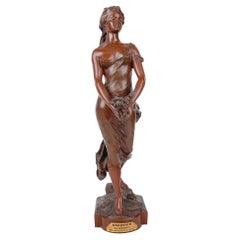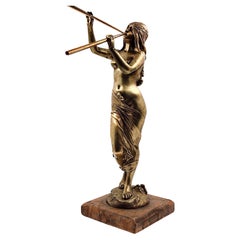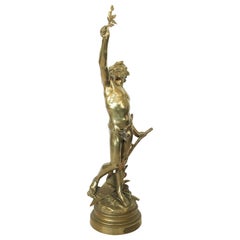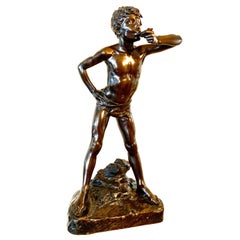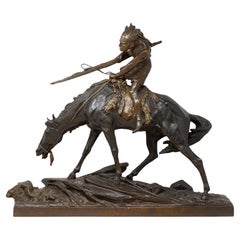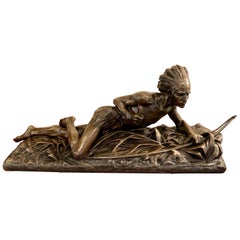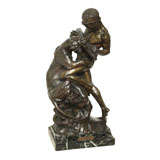Edouard Drouot Bronze
Antique Late 19th Century French Figurative Sculptures
Bronze
Antique Late 19th Century French Belle Époque Figurative Sculptures
Bronze
20th Century French Belle Époque Figurative Sculptures
Marble, Bronze
Antique Late 19th Century Animal Sculptures
Bronze
Antique Late 19th Century French Belle Époque Figurative Sculptures
Marble, Bronze
Antique 19th Century French Figurative Sculptures
Bronze
Antique 19th Century French Romantic Figurative Sculptures
Bronze
Antique Late 19th Century French Late Victorian Figurative Sculptures
Bronze
Antique Late 19th Century French Romantic Figurative Sculptures
Bronze
Early 20th Century French Art Deco Animal Sculptures
Bronze
Antique Late 19th Century French Native American Figurative Sculptures
Marble, Bronze
Antique Late 19th Century French Animal Sculptures
Bronze
Early 20th Century French Figurative Sculptures
Bronze
Antique Late 19th Century French Belle Époque Figurative Sculptures
Bronze
Antique 19th Century French Napoleon III Figurative Sculptures
Bronze
Antique 19th Century French Classical Greek Figurative Sculptures
Marble, Bronze
Antique 19th Century French Louis XVI Figurative Sculptures
Bronze, Ormolu
Antique Late 19th Century French Modern Busts
Bronze
20th Century French Romantic Animal Sculptures
Marble, Bronze
Late 19th Century Figurative Sculptures
Bronze
Recent Sales
Vintage 1920s French Art Deco Figurative Sculptures
Bronze
Early 20th Century French Sculptures
Marble, Bronze
Antique Early 1900s French Belle Époque Figurative Sculptures
Bronze
19th Century Figurative Sculptures
Marble, Bronze
Antique 19th Century French Figurative Sculptures
Marble, Bronze
Antique Late 19th Century French Sculptures
Marble, Bronze
Late 19th Century Figurative Sculptures
Marble, Bronze
Antique Late 19th Century French Animal Sculptures
Bronze
Early 20th Century European Neoclassical Revival Figurative Sculptures
Bronze
Vintage 1910s French Art Deco Figurative Sculptures
Marble, Bronze
Antique 19th Century French Statues
Bronze
Late 19th Century Romantic Sculptures
Bronze
Antique 1890s French Figurative Sculptures
Bronze
Antique Late 19th Century French Victorian Figurative Sculptures
Marble, Bronze
20th Century French Romantic Figurative Sculptures
Marble, Bronze
Early 20th Century French Art Deco Figurative Sculptures
Bronze
Antique Late 19th Century French Belle Époque Figurative Sculptures
Bronze
Vintage 1910s French Art Nouveau Figurative Sculptures
Bronze
Antique Late 19th Century French Figurative Sculptures
Bronze
Antique Early 1900s French Other Figurative Sculptures
Bronze
Vintage 1920s French Art Deco Figurative Sculptures
Bronze
Early 20th Century French Art Deco Animal Sculptures
Bronze
Antique Late 19th Century French Art Nouveau Figurative Sculptures
Bronze
Antique Late 19th Century French Belle Époque Figurative Sculptures
Marble, Bronze
Early 20th Century Art Deco Mounted Objects
Bronze
Vintage 1920s French Art Deco Figurative Sculptures
Marble, Bronze
Antique 1860s French Figurative Sculptures
Marble, Bronze, Ormolu
Early 20th Century French Art Deco Sculptures
Bronze
Antique 1890s French Table Lamps
Marble, Bronze
Antique 1890s French Art Nouveau Figurative Sculptures
Bronze
Early 20th Century French Sculptures
Bronze
Antique Late 19th Century French Art Nouveau Figurative Sculptures
Bronze
20th Century French Art Deco Figurative Sculptures
Bronze
Antique 19th Century French Figurative Sculptures
Marble, Gold, Bronze
20th Century French Art Deco Figurative Sculptures
Bronze
Antique Late 19th Century French Beaux Arts Figurative Sculptures
Marble, Bronze
Antique 19th Century French Figurative Sculptures
Bronze
Antique Late 19th Century French Animal Sculptures
Marble, Bronze
Antique 19th Century French Neoclassical Figurative Sculptures
Bronze
Antique Late 19th Century French Art Nouveau Figurative Sculptures
Marble, Bronze
Early 20th Century French Sculptures
Marble, Bronze
Early 20th Century French Sculptures
Marble, Bronze
Early 20th Century Figurative Sculptures
Bronze
Early 1900s Art Nouveau Figurative Sculptures
Bronze
Antique Early 19th Century Figurative Sculptures
Bronze
Antique 1880s French Beaux Arts Figurative Sculptures
Bronze
Vintage 1920s French Figurative Sculptures
Bronze
Antique 1890s French Figurative Sculptures
Bronze
Antique 19th Century French Figurative Sculptures
Bronze
Antique 19th Century French Country Animal Sculptures
Marble, Bronze
Antique Early 1900s French Belle Époque Figurative Sculptures
Antique 1890s French Figurative Sculptures
Marble, Bronze
Antique 19th Century French Animal Sculptures
Bronze
Early 1900s Art Nouveau Figurative Sculptures
Bronze
Early 20th Century Realist Figurative Sculptures
Bronze
Vintage 1910s French Art Nouveau Figurative Sculptures
Marble, Bronze
19th Century Sculptures
Bronze
Early 20th Century Sculptures
Bronze
People Also Browsed
Antique 1870s French Classical Roman Figurative Sculptures
Bronze
Antique 19th Century French Romantic Figurative Sculptures
Bronze
Edouard Drouot Bronze For Sale on 1stDibs
How Much is a Edouard Drouot Bronze?
Finding the Right Sculptures for You
Styling your home with vintage, new and antique sculptures means adding a touch that can meaningfully transform the space. By introducing a sculptural work as a decorative finish to any interior, you’re making a statement, whether you tend toward the dramatic or prefer to keep things casual with modest, understated art.
A single, one-of-a-kind three-dimensional figurative sculpture mounted on your dining room wall is a guaranteed conversation piece, while a trio of abstract works arranged on your living room bookshelves can add spontaneity to the collection of first-edition novels or artist monographs you’re displaying as well as draw attention to them. Figurative sculptures are representational works that portray a specific person, animal or object. And while decorating with busts, which are sculpted or cast figurative works, hasn’t exactly topped the list of design trends every year, busts are back. According to designer Timothy Corrigan, “They give humanity in a way that a more abstract sculpture can’t give.” Abstract sculptures, on the other hand, are not meant to show something specific. Instead, they invoke a mood or scene without directly stating what they are portraying.
Busts made of stone or metal may not seem like a good fit for your existing decor. Fortunately, there are many ways for a seemingly incongruous piece to fit in with the rest of your room’s theme. You can embrace a dramatic piece by making it the focal point of the room, or you can choose to incorporate several elements made out of the same material to create harmony in your space. If an antique or more dramatic piece doesn’t feel like you, why not opt for works comprising plastic, fiberglass or other more modern materials?
When incorporating sculpture into the design of your home — be it the playful work of auction hero and multimedia visionary KAWS, contemporary fiber art from Connecticut dealer browngrotta arts or still-life sculpture on a budget — consider proper lighting, which can bring out the distinctive aspects of your piece that deserve attention. And make sure you know how the size and form of the sculpture will affect your space in whole. If you choose a sculpture with dramatic design elements, such as sharp angles or bright colors, for example, try to better integrate this new addition by echoing those elements in the rest of your room’s design.
Get started on decorating with sculpture now — find figurative sculptures, animal sculptures and more on 1stDibs today.
Read More
Kazuyo Sejima’s Flowering Tree Blooms Year-Round
The brilliantly simple design turns a modest bouquet into a major statement.
He Wrote ‘Oedipus Rex,’ but Do You Know What He Looked Like?
The Greek tragedian is said to have been handsome in his day.
Cigar Culture Was Once the Peak of Masculinity. Now, It’s a Compelling Curiosity
Even for those who don’t indulge, elegant smoking accessories and audacious art portraying cigar enthusiasts hold a nostalgic allure.
African Travel Plans on Hold? This Ardmore Leopard Vase Brings the Beauty of the Savanna to You
It’s an excellent example of the sought-after ceramics coming out of South Africa’s KwaZulu-Natal province.
With a High-Tech Flagship and Cool Collabs, Lladró Is Breaking the Mold for Porcelain Production
Thanks to its new leadership, the Spanish maker of figurines, busts and lighting is on a mission to update the art of porcelain for the 21st century.
Zoë Powell’s Magnolia 05 Vessel Is Handmade from Clay She Unearthed Herself
The free-form stoneware piece is inspired by the magnolia tree and its associations with home.
8 Ways to Breathe New Life into a Space with Plants
The pair behind the Instagram account @houseplantclub share their tips for making any room of the house gloriously green.
Paris Gallerist Sandy Toupenet Gets Fired Up over 20th-Century Ceramics and Inventive New Makers
Her space on the city’s Left Bank mixes mid-century pieces by the likes of Jean Cocteau and Pablo Picasso with whimsical contemporary creations.

